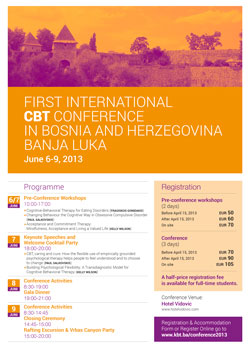Banja Luka
Banja Luka is the second largest city in Bosnia and Herzegovina. It is home of the University of Banja Luka, as well as numerous state and entity institutions of Bosnia and Herzegovina. The city lies on the Vrbas river and is well known in the countries of the Former Yugoslavia for being full of tree-lined avenues, boulevards, gardens, and parks. Banja Luka has also a number of springs close by. The area around Banja Luka is mostly woodland. The city itself is built in the Banja Luka valley, which is located at the transition between high and low mountain areas.
Banja Luka has a continental climate, with harsh winters and warm summers. The warmest month of the year is July, with an average temperature of 21.3 °C (70.3 °F).
History
The history of inhabitation of the area of Banja Luka dates back to ancient times. There is a substantial evidence of the Roman presence in the region during the first few centuries A.D., including an old fort "Kastel" in the centre of the city. Slavs settled in the Balkans in the 6th century. During the Ottoman rule in Bosnia, Banja Luka was the seat of the Bosnian pashaluk, and the lords of the region built what is nowadays the main street of the city and over 200 projects ranging from artisan and sales shops to wheat warehouses, baths and mosques. Among more important constructions were the Ferhadija and Arnaudija mosques.
In 1688, the city was burned down by the Austrian army, but it quickly recovered. Later periodic intrusions by the Austrian army stimulated military developments in Banja Luka, which made it into a strategic military centre. Orthodox churches and monasteries near Banja Luka were built in the 19th century. Also, Sephardic Jews and Trappists migrated to the city in the 19th century and contributed to the early industrialization of the region by building mills, breweries, brick factories, textile factories and other important structures.
For all its leadership to the region however, Banja Luka as a city was not modernised until Austro-Hungarian occupation in the late 19th century that brought westernisation to Banja Luka. Railroads, schools, factories, and infrastructure appeared, and were developed, which led to a modern city. A Roman Catholic Franciscan monastery was built in the 20th century.
After World War I, the town became the capital of the Vrbas Banovina, a province of the Kingdom of Yugoslavia. The provincial capital owed its rapid progress to the first Ban Svetislav Milosavljević. During that time, the Banski dvor and its twin sister, the Administration building, the Serbian Orthodox Church of the Holy Trinity, a theatre and a museum were built.
Culture
Due to its long history, Banja Luka is rich in culture. Banja Luka is the home of several museums, the national theatre and library, both dating from the first half of the 20th century, and of numerous other theatres.
Fortress "Kastel" is one of Banja Luka’s main attractions. Located on the left bank of the Vrbas river, it gives a specific charm to the city. During the summer, music concerts take place in the fortress. In the summer, there are many festivals, with live bands playing at the outdoor venues.
Tourism
The city and the natural beauties of the surrounding area boast a number of popular tourist attractions. Among the most famous are the pools, thermal springs, and spas in the region. Due to its parks and over 10 000 trees Banja Luka was once nicknamed the "Green City". The area is popular among nature lovers, while the city centre is attractive to tourists due to its historical structures and many restaurants. Other attractions of Banja Luka are the Banj Hill and a waterfall of the Vrbas river near Krupa.
Rafting on the Vrbas river is currently becoming popular among the tourists. The Vrbas River was home to the 2005 European Whitewater Rafting Championships and World Championship 2009. The Vrbas Canyon is an ideal place for water adventures like kayaking and rafting. The canyon walls are home to hawks, eagles and falcons as well. The highlands are dotted with many old villages that offer a stark contrast to the beat of the Banja Luka city center.
